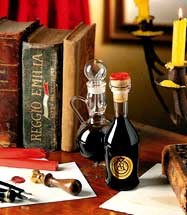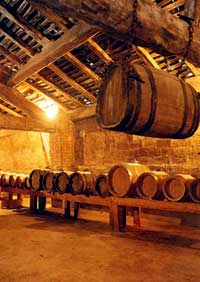|
Apart from carrying the flag of the town throughout the world, Tradition Balsamic Vinegar from Reggio Emilia is a
symbol of one of the most universally laved and appreciated Italian cuisines.
Born centuries ago as a medicinal balsam for the exclusive use of kings and emperors,it has found its place
in the kitchen as a product of excellence, it heightens the flavours and enriches every dish, from the most
simples ones such as salads and raw vegetables, to the most refined dishes such as filled pastas or meats.
Among the thousands of possibilities, the dearest "love affair" is most certainly that of
Tradition Balsamic Vinegar
and Parmigiano-reggiano cheese.
Its ancient roots are the most part unknown, and surround the "most special vinegar in the world" with a veil
of mistery.
The earliest ancient writing which mention it date back to the year 1046, when the Emperor of Germany, Henry II,
travelling to Rome for the coronation, stopped in Piacenza. From here wrote to Boniface, father of the famous
Countess Matilde of Canossa, asking for a gift of a special vinegar which he had heard flows in the most
perfect manner.
After the imperial imprimatur, during the whole Renaissance period, Balsamic Vinegar often appeared on the tables
of the kings and the nobility, particularly at the table of the Duckes of Este.
QUALITY CONTROL
When Tradition Balsamic Vinegar from Reggio Emilia arrives at the table, it has been throught not only
an ageing process of at least twelve years in barrels, but also a strict exam by a Commision of expert tastres
who analyse its organoleptic characterics.
The regulations in fact have precise requirements for Tradition Balsamic Vinegar from Reggio.
The Commission, made up of five randomly selected tasters, tastes anonymous samples and judges their
characteristics.
The evaluation confirms whether the product is suitable to be marketed, or if it needs to be returned to
the barrels for further improvement.
Following the official points conferral, the specific quality of the product is identified and the seals bearing
the Consortium mark, in different colours, (lobster red, silver and gold) awarded according to categopry.
These strict and coded control criteria provide the best quality guarantee for the consumer, while the three stamps
-typical of the T.B.V. from Reggio Emilia - are useful for directing the consumer in his choice.
|



|





